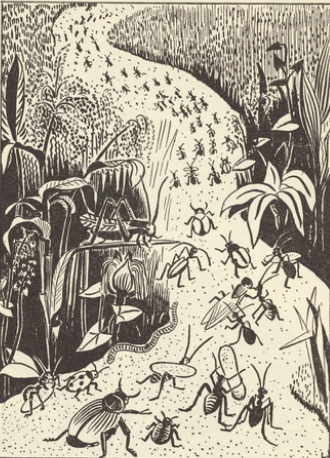In the Grass
By Effie Lee Newsome
Annotations by Karen Kilcup

by Lois Mailou Jones. Public Domain.
Sometimes I lie in meadow grass, And watch all kinds of insect pass In brown and red and gray. Some very busy ants speed by With white crumb bundles stacked up high, All hastening one way. Each hurries with his heavy load Up what I call the Cricket Road, It looks so cool and dark. There’s pleasant millet growing there,[1] And wisps of fox-grass everywhere[2] That I use as a cane To push along some lazy bug, That lags without a load to lug Along the insect land. And bugs keep coming on and on— New bands before the old have gone. Sometimes one comes alone. A grasshopper quick, proud and lean Leaps to the millet, tall and green, And takes it for this throne. Sometimes a beetle blunders past Or stops awhile, then starts out, fast, As though he’d heard a call. Sometimes a soft green worm drags by, Then winds beneath a millet sky, And can’t be seen at all. Each worm and bug moves on its way. Some tap the grass, as though in play. But I like best the ants’ long strong Returning from their marketing.
Newsome, Effie Lee. “In the Grass.” Gladiola Garden: Poems of Outdoors and Indoors for Second Grade Readers. Washington, DC: Associated Publishers, 1940, 9-10.
[1] Millet is an ancient type of grass often grown for its grain. Newsome imagines herself down in the grass with the insects, so the millet seems like a forest.
[2] Foxtail grasses, considered a weed, can reach as much as three feet tall. The seeds are dangerous for livestock to eat.
Contexts
Newsome worked among the many celebrated writers of the Harlem Renaissance, who included Langston Hughes, Countee Cullen, James Weldon Johnson, Zora Neale Hurston, and Anne Spencer, many of them poets. Among her noteworthy contributions to that movement was her writing and editing for W. E. B. Du Bois’s magazine, The Crisis, the official publication of the NAACP (National Association for the Advancement of Colored People). As John Claborn points out, Du Bois’s political goals embraced the idea of access to natural spaces, and the magazine featured environmental writing by such notable authors as Arna Bontemps, Claude McKay, and Hughes. Newsome contributed to and edited “The Little Page” (“Whimsies for the Younger Folk”), where much of her work emphasized nature. This poem, like many others in The Envious Lobster, whimsically enacts a natural history lesson, while it encourages children’s imagination.
Resources for Further Study
- Claborn, John. “The Crisis, the Politics of Nature, and the Harlem Renaissance: Effie Lee Newsome’s Eco-poetics.” Civil Rights and the Environment in African-American Literature, 1895-1941. New York: Bloomsbury Academic, 2017.
- “Effie Lee Newsome, 1885-1978.” Poets.org. This site provides access to seven of Newsome’s poems.
- Newsome, Effie Lee. Gladiola Garden: Poems of Outdoors and Indoors for Second Grade Readers. Courtesy of the New York Public Library, this site provides access to the entire text.
Contemporary Connections
Anonymous. Reading of Newsome’s poem, “The Bronze Legacy.” The illustrations for Gladiola Garden were done by prominent Black artist Loïs Mailou Jones (1905-1998).
Johnston, Amber O’Neal. “African American Poetry: Effie Lee Newsome. Heritage Mom blog.